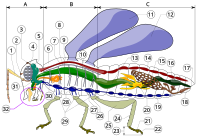
Photo from wikipedia
ABSTRACT Increased lateral trunk bending to the injured side has been observed when ACL injuries occur. The purpose was to quantify the effect of mid-flight lateral trunk bending on center… Click to show full abstract
ABSTRACT Increased lateral trunk bending to the injured side has been observed when ACL injuries occur. The purpose was to quantify the effect of mid-flight lateral trunk bending on center of mass (COM) positions and subsequent landing mechanics during a jump-landing task. Forty-one recreational athletes performed a jump-landing task with or without mid-flight lateral trunk bending. When the left and right trunk bending conditions were compared with the no trunk bending condition, participants moved the COM of the upper body to the bending direction, while the COM of the pelvis, ipsilateral leg, and contralateral leg moved away from the bending direction relative to the whole body COM. Participants demonstrated increased peak vertical ground reaction forces (VGRF) and knee valgus and internal rotation angles at peak VGRF for the ipsilateral leg, but decreased peak VGRF and knee internal rotation angles at peak VGRF and increased knee varus angles at peak VGRF for the contralateral leg. Mid-flight lateral trunk resulted in an asymmetric landing pattern associated with increased ACL loading for the ipsilateral leg. The findings may help to understand altered trunk motion during ACL injury events and the discrepancy in ACL injuries related to limb dominance in badminton and volleyball.
Journal Title: Journal of Sports Sciences
Year Published: 2018
Link to full text (if available)
Share on Social Media: Sign Up to like & get
recommendations!